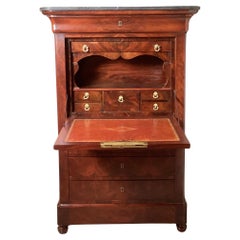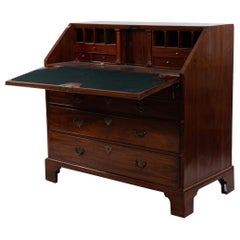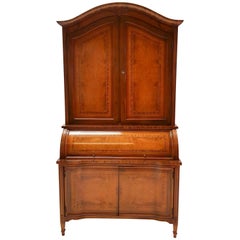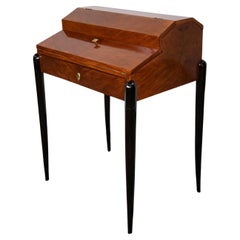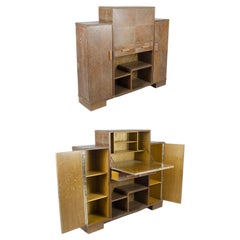Secretaires
Early 19th Century French Empire Antique Secretaires
Mahogany
19th Century American Country Antique Secretaires
Mahogany
Mid-20th Century Dutch Louis XVI Secretaires
Wood
Mid-19th Century German Biedermeier Antique Secretaires
Wood
1930s French Art Deco Vintage Secretaires
Mahogany
Early 20th Century French Art Deco Secretaires
Metal
1890s English Adam Style Antique Secretaires
Satinwood
Early 19th Century English Queen Anne Antique Secretaires
Wood
1810s French Louis Philippe Antique Secretaires
Marble, Brass
1770s German Louis XVI Antique Secretaires
Walnut
19th Century French Napoleon III Antique Secretaires
Marble
1780s English Chippendale Antique Secretaires
Brass
Early 19th Century English Sheraton Antique Secretaires
Mahogany
Late 19th Century French Louis XV Antique Secretaires
Bronze
1750s French Louis XV Antique Secretaires
Birdseye Maple, Maple, Walnut
2010s French Modern Secretaires
Steel
1750s German Baroque Antique Secretaires
Elm, Walnut
1810s Japanese Edo Antique Secretaires
Mother-of-Pearl, Wood
Early 20th Century English Edwardian Secretaires
Walnut
1790s American Hepplewhite Antique Secretaires
Brass
Mid-19th Century French Louis XV Antique Secretaires
Leather, Oak
Mid-19th Century Swedish Country Antique Secretaires
Pine
19th Century Indonesian Antique Secretaires
Wood
18th Century Swedish Antique Secretaires
Wood
1860s English Gothic Revival Antique Secretaires
Oak
Early 20th Century American Victorian Secretaires
Wood
Early 1900s Dutch Dutch Colonial Antique Secretaires
Mirror, Satinwood, Walnut
1960s Italian Mid-Century Modern Vintage Secretaires
Brass
Late 19th Century American Victorian Antique Secretaires
Glass, Wood, Walnut
1820s German Biedermeier Antique Secretaires
Mahogany, Walnut
18th Century British George I Antique Secretaires
Walnut, Burl
2010s American Minimalist Secretaires
Aluminum
19th Century French Empire Antique Secretaires
Bronze
1820s English George IV Antique Secretaires
Walnut
1960s Danish Mid-Century Modern Vintage Secretaires
Rosewood
1950s Danish Mid-Century Modern Vintage Secretaires
Teak
Early 19th Century English Antique Secretaires
Blown Glass, Mahogany
1820s German Biedermeier Antique Secretaires
Leather, Birch, Cherry
Mid-20th Century Danish Scandinavian Modern Secretaires
Teak
Late 20th Century German Scandinavian Modern Secretaires
Pine
Early 19th Century French Restauration Antique Secretaires
Leather, Walnut
1780s English George III Antique Secretaires
Walnut
19th Century French Louis XVI Antique Secretaires
Marble, Bronze, Gold Leaf
20th Century Italian George III Secretaires
Brass
Early 19th Century Italian Baroque Revival Antique Secretaires
Walnut, Burl
Early 1900s French Louis XV Antique Secretaires
Oak
1940s American Vintage Secretaires
Mahogany
1780s French Louis XVI Antique Secretaires
Kingwood, Yew
1830s French Louis Philippe Antique Secretaires
Amboyna
Early 18th Century Baroque Antique Secretaires
Maple, Olive
19th Century German Biedermeier Antique Secretaires
Mahogany, Wood
1840s Danish Antique Secretaires
Mahogany
1720s English Queen Anne Antique Secretaires
Oak
1860s French Directoire Antique Secretaires
Mahogany, Satinwood
1790s French Louis XVI Antique Secretaires
Walnut
Late 19th Century Italian Antique Secretaires
Walnut
Late 18th Century French Antique Secretaires
Brass
18th Century and Earlier French Louis XVI Antique Secretaires
Leather, Cherry
20th Century Italian Louis XV Secretaires
Mirror, Wood
19th Century French Empire Antique Secretaires
Bronze
Antique, New and Vintage Secretaires
Your antique, new or vintage secretary desk has become the (chic) saving grace of the "new normal" at home.
Simply put, a secretary desk is a multifunctional piece of furniture with a hinged writing surface that folds open or drops down. When the leaf is folded out, small inner storage compartments — pigeonholes, cubbies, recesses or drawers — are revealed.
Traditionally, a secretary is composed of two parts — a chest of drawers on the bottom and a cabinet with shelves on the top. Taking its name from the French word for the piece, secrétaire, the secretary desk dates back to the 18th century, when Paris-based cabinetmaker Jean-François Oeben, known for his exquisite marquetry and clever mechanical desks, is thought to have invented the secrétaire à abbattant, or drop-leaf desk.
While the defining drop-down feature of the secretary desk has remained constant, the materials used, as well as its configuration, size and style have evolved over time.
At first, secretaries were typically made from exotic woods, like rosewood, tulipwood and kingwood; later, hardwoods like cherry, maple, oak and mahogany were more common. The desks also became lighter, with space carved out of the lower half for the writer’s feet or with drawers replaced by legs — making them more table-like.
When open, the secretary is a dynamic, versatile Wunderkammer. When closed, it’s a sophisticated, space-saving piece of furniture.
“A fine secretary with a good provenance adds stature and credence to its owner — it is a cornerstone piece,” says antiques dealer Stanley Weiss, who specializes in 18th- and 19th-century English and American furniture. “In this disposable world, fine furniture is always passed on and speaks to who its owner is.”
No matter what style or period you choose, and no matter how you decide to use it, the timeless, flexible secretary desk is bound to become an indispensable part of your daily routine.
Browse a range of antique and vintage secretary desks on 1stDibs, including mid-century modern secretaires, Georgian secretaires and others.
